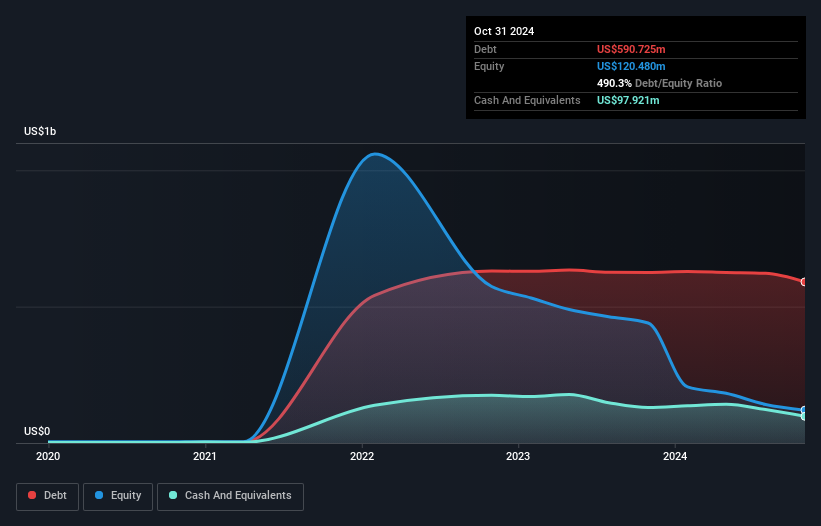
Warren Buffett famously said, 'Volatility is far from synonymous with risk.' It's only natural to consider a company's balance sheet when you examine how risky it is, since debt is often involved when a business collapses. As with many other companies Skillsoft Corp. (NYSE:SKIL) makes use of debt. But should shareholders be worried about its use of debt?
What Risk Does Debt Bring?
Debt assists a business until the business has trouble paying it off, either with new capital or with free cash flow. In the worst case scenario, a company can go bankrupt if it cannot pay its creditors. While that is not too common, we often do see indebted companies permanently diluting shareholders because lenders force them to raise capital at a distressed price. Of course, debt can be an important tool in businesses, particularly capital heavy businesses. The first step when considering a company's debt levels is to consider its cash and debt together.
How Much Debt Does Skillsoft Carry?
As you can see below, Skillsoft had US$590.7m of debt at October 2024, down from US$625.5m a year prior. On the flip side, it has US$97.9m in cash leading to net debt of about US$492.8m.

How Strong Is Skillsoft's Balance Sheet?
Zooming in on the latest balance sheet data, we can see that Skillsoft had liabilities of US$294.0m due within 12 months and liabilities of US$639.1m due beyond that. Offsetting these obligations, it had cash of US$97.9m as well as receivables valued at US$102.5m due within 12 months. So it has liabilities totalling US$732.6m more than its cash and near-term receivables, combined.
The deficiency here weighs heavily on the US$162.7m company itself, as if a child were struggling under the weight of an enormous back-pack full of books, his sports gear, and a trumpet. So we'd watch its balance sheet closely, without a doubt. At the end of the day, Skillsoft would probably need a major re-capitalization if its creditors were to demand repayment. When analysing debt levels, the balance sheet is the obvious place to start. But it is future earnings, more than anything, that will determine Skillsoft's ability to maintain a healthy balance sheet going forward. So if you're focused on the future you can check out this free report showing analyst profit forecasts.
View our latest analysis for Skillsoft
In the last year Skillsoft had a loss before interest and tax, and actually shrunk its revenue by 3.8%, to US$535m. That's not what we would hope to see.
Caveat Emptor
Over the last twelve months Skillsoft produced an earnings before interest and tax (EBIT) loss. Its EBIT loss was a whopping US$52m. If you consider the significant liabilities mentioned above, we are extremely wary of this investment. Of course, it may be able to improve its situation with a bit of luck and good execution. But we think that is unlikely since it is low on liquid assets, and made a loss of US$336m in the last year. So while it's not wise to assume the company will fail, we do think it's risky. There's no doubt that we learn most about debt from the balance sheet. However, not all investment risk resides within the balance sheet - far from it. Be aware that Skillsoft is showing 1 warning sign in our investment analysis , you should know about...
At the end of the day, it's often better to focus on companies that are free from net debt. You can access our special list of such companies (all with a track record of profit growth). It's free.
New: Manage All Your Stock Portfolios in One Place
We've created the ultimate portfolio companion for stock investors, and it's free.
• Connect an unlimited number of Portfolios and see your total in one currency
• Be alerted to new Warning Signs or Risks via email or mobile
• Track the Fair Value of your stocks
Have feedback on this article? Concerned about the content? Get in touch with us directly. Alternatively, email editorial-team (at) simplywallst.com.
This article by Simply Wall St is general in nature. We provide commentary based on historical data and analyst forecasts only using an unbiased methodology and our articles are not intended to be financial advice. It does not constitute a recommendation to buy or sell any stock, and does not take account of your objectives, or your financial situation. We aim to bring you long-term focused analysis driven by fundamental data. Note that our analysis may not factor in the latest price-sensitive company announcements or qualitative material. Simply Wall St has no position in any stocks mentioned.
About NYSE:SKIL
Skillsoft
Provides content and platform and instructor-led training services in the United States and internationally.
Good value with imperfect balance sheet.


